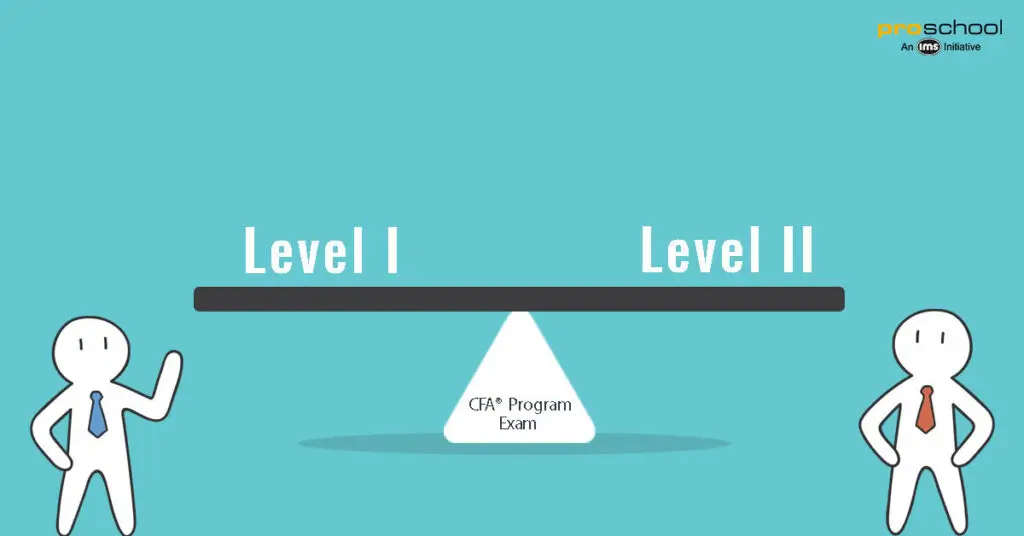List of the Top 10 Differences between the L I and L II CFA® Program Exams

Here's What We've Covered!
Passing Level I of the CFA® Program exam is the first milestone in your journey towards an international designation. After putting a lot of hard work and strategies in clearing the examination, you now have to gear up for Level II. The next level is a different ball game altogether. While the first level is about understanding the fundamentals of investment valuation, Level II is more practical in nature. In Level II, you learn how to apply the concepts of investment analysis and portfolio management to real-life situations.
In a nutshell, Level II differs on a lot of factors from level I. Here is a list of differentiating factors between the two levels.
(1) The frequency of exams:
Level I: The exams are held twice a year, in the month of June and December.
Level II: The exams are held only once a year in the month of June.
(2) The format of the exams:
Level I: Multiple Choice questions with a total of 240 questions.
Level II: Total 120 Multiple Choice Questions divided into 20 item sets of 6 questions each. Each exam session, one in the morning and one in the afternoon, tests you on 10 sets. For each of the question set, you will be offered a piece of information or case study and there will be 6 questions which require you to use the information for arriving at a solution.
(3) Curriculum
Level I: The focus is more on investment tools. You get introduced to many investment tools and understand them conceptually.
Level II: The focus is mainly on valuations. You are taught the valuation perspective in an exhaustive manner. A variety of asset classes are also covered in Level II.
(4) Subjects and topic weightages:
| TOPIC AREA | LEVEL I | LEVEL II |
| Ethics & Professional Standards | 10-15% | 10-15% |
| Quantitative Methods | 10% | 5-10% |
| Economics | 10% | 5-10% |
| Financial Reporting & Analysis | 15% | 10-15% |
| Corporate Finance | 10% | 5-10% |
| Equity Investments | 10% | 10-15% |
| Fixed Income | 10% | 10-15% |
| Derivative Investments | 6% | 5-10% |
| Alternative Investments | 6% | 5-10% |
| Portfolio Management & Wealth Management | 6% | 5-15% |
(5) Integration of topics
Level I: The questions are very straightforward. Each question sticks to one topic. Integration of topics is very limited in Level I.
Level II: The questions in Level II are more nuanced. If you have an item set on Equity Valuation, you could also be questioned on the Dividend Discount Model and Cost of Capital in the same set. So you can expect integration of various topics in each item set.
(6) Level of Difficulty
Level 1: The level of difficulty for level I is the lowest out of all the three levels. The questions are more direct and less time consuming to solve.
Level II: The second level is a tad difficult than the first one. The number of questions is lesser than that of Level I but it is more challenging. The topics become more complex and the format of questions has a stark difference. You need to read each vignette and understand it fully to answer the questions that follow. So solving the paper requires a lot of practice and efficient time management skills.
(7) Preparation Time
Level I: Time required for Level I preparation is approximately 300 hours. Some students also clock in 312 hours of preparation, while some clock in 292 hours.
Level II: The time required for level II preparation is 328-330 hours on an average. The preparation time is typically spread over a period of 6 months which comes to 12.5 hours per week.
Note: The preparation time varies across student and the training provider
(8) Passing percentage
The pass percentages for both the levels for the past three years are as follows:
| Year | Level I | Level II |
| 2016 | 43% | 46% |
| 2017 | 43% | 47% |
| 2018 | 43% | 45% |
(9) Reading Materials
Level I: The study material for level I is more focussed on conceptual clarity and introduction of key terminologies. Certain subjects like Economics, Quantitative Methods are covered in more details.
Level II: The study material for level II is twenty times deeper. The material is more exhaustive and wordy. Every topic in each of the subject is covered in the utmost details. There is increased material in terms of quantity and readings. Hence you need to allocate more time for understanding the entire study material in depth.
(10) Preparation strategies
Level I: You must aim to understand each of the concepts thoroughly. Though the questions are direct, however, it may be tweaked to test your problem-solving skills. Hence, the focus should be to have good calculation and judgement skills.
Level II: You need to understand each concept in much more details that Level I. Not just the concept, you also need to understand how to apply these concepts in the real-life scenarios. Hence, more and more practise is needed. You must also work on time distribution. You need to focus on the subjects which carry more weight. Special importance must be given to Ethics, Financial Reporting & Analysis, Equity Investment and Fixed income because these comprise 50-80% of the questions.
Reference:
Resent Post
>
Emerging commerce career options in India (2026): From CA to Data Analyst
>
ACCA Opportunities You Didn’t Know About – Think Beyond Audit!
>
Which Courses After 12th Commerce With High Salary Are in Demand Worldwide?
>
How to Find ACCA Jobs Online After Qualifying: Real Portals, Tips & Career Guidance
>
Financial Modelling Classes in Hyderabad: Your Guide to the Best Institutes
Follow Us For All Updates!



